Abstract
Human glutathione transferases (GSTs) are a multigene family of enzymes that are involved in the metabolism of a wide range of electrophilic compounds of both exogenous and endogenous origin. GSTs are generally recognized as detoxifying enzymes by catalyzing the conjugation of these compounds with glutathione, but they may also be involved in activation of some carcinogens. The memmalian GSTs can be differentiated into four classes of cytosolic enzymes and two membrane bound enzymes. Human epoxide hydrolases (EHs) catalyze the addition of water to epoxides to form the corresponding dihydrodiol. The enzymatic hydration is essentially irreversible and produces mainly metabolites of lower reactivity that can be conjugated and excreted. The reaction of EHs is therefore generally regarded as detoxifying. The mammalian EHs can be distinguished by their physical and enzymatic properties. Microsomal EH (mEH) exhibits a broad substrate specificity, while the soluble EH (sEH) is an enzyme with a "complementary" substrate specificity to mEH. Cholesterol EH and leukotriene A4 hydrolase are two EHs with very limited substrate specificity. The activities of either GSTs or EHs expressed in vivo exhibit a relatively large interindividual variation, which might be explained by induction, inhibition, or genetic factors. These variations in levels or activities of individual isoenzymes are of importance with respect to an individual's susceptibility to genotoxic effects. This article gives a general overview of GSTs and EHs, discussing the modulation of activities, determination of these enzymes ex vivo, and the polymorphic expression of some isoenzymes.
Full text
PDF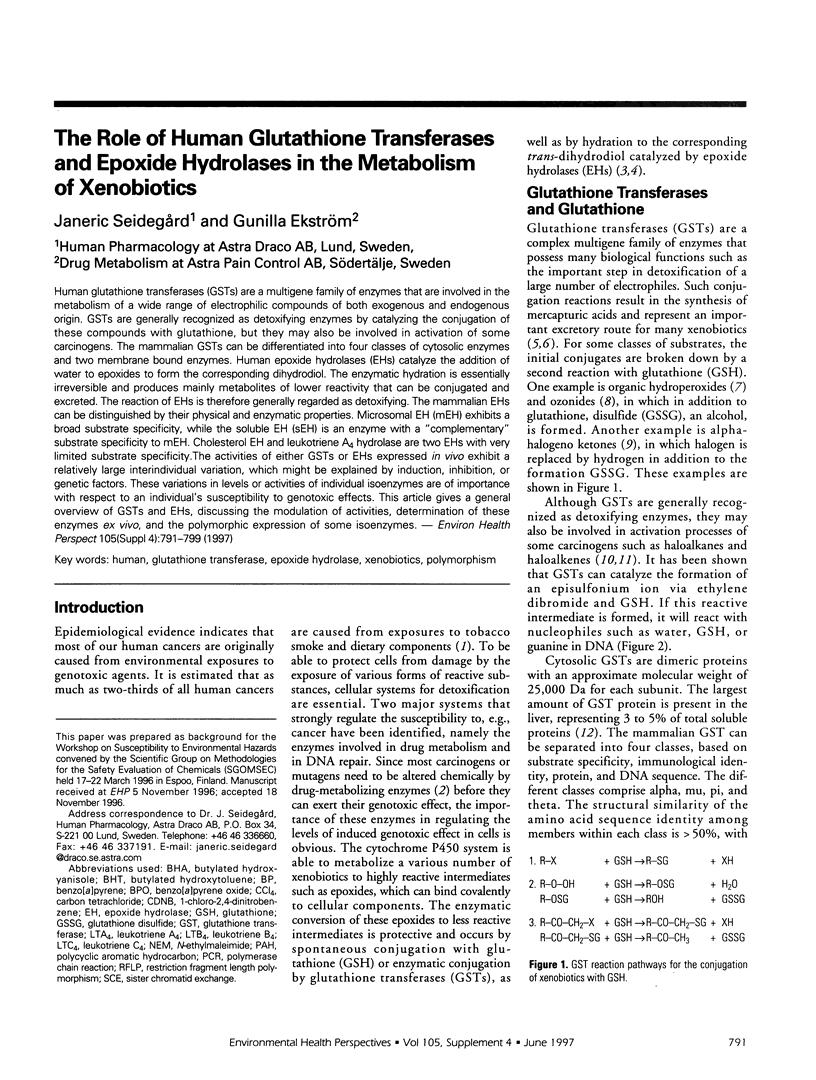
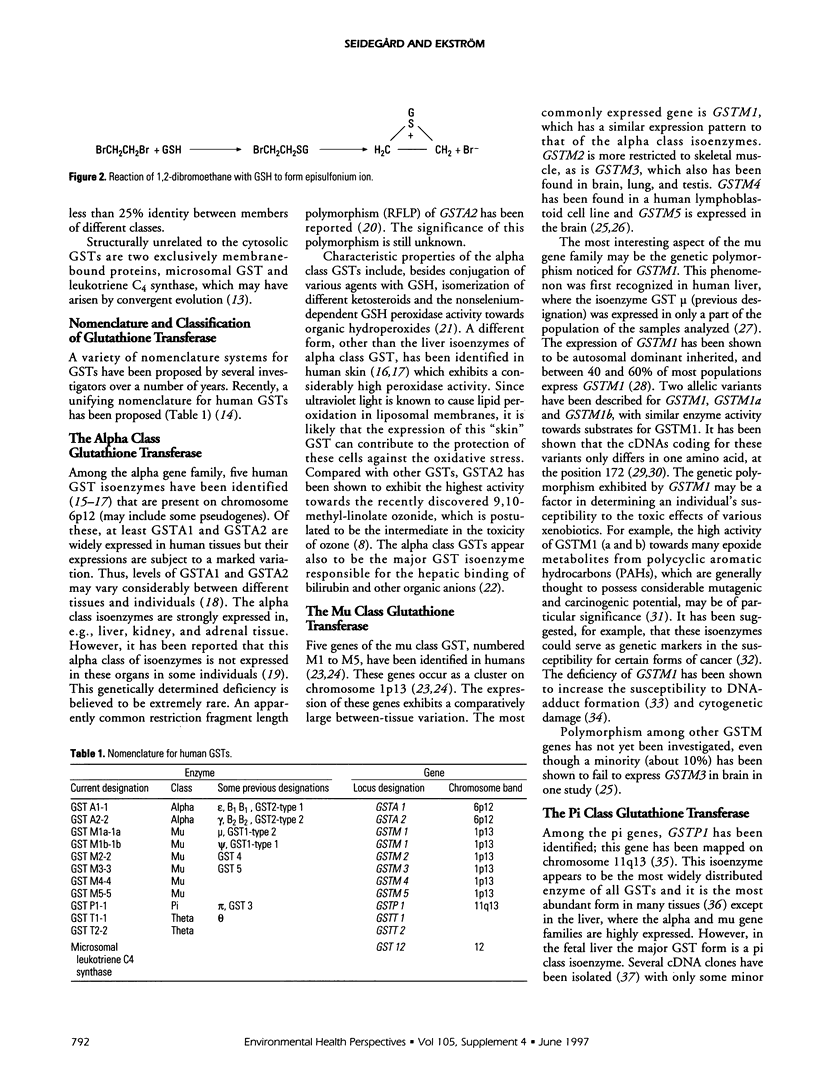


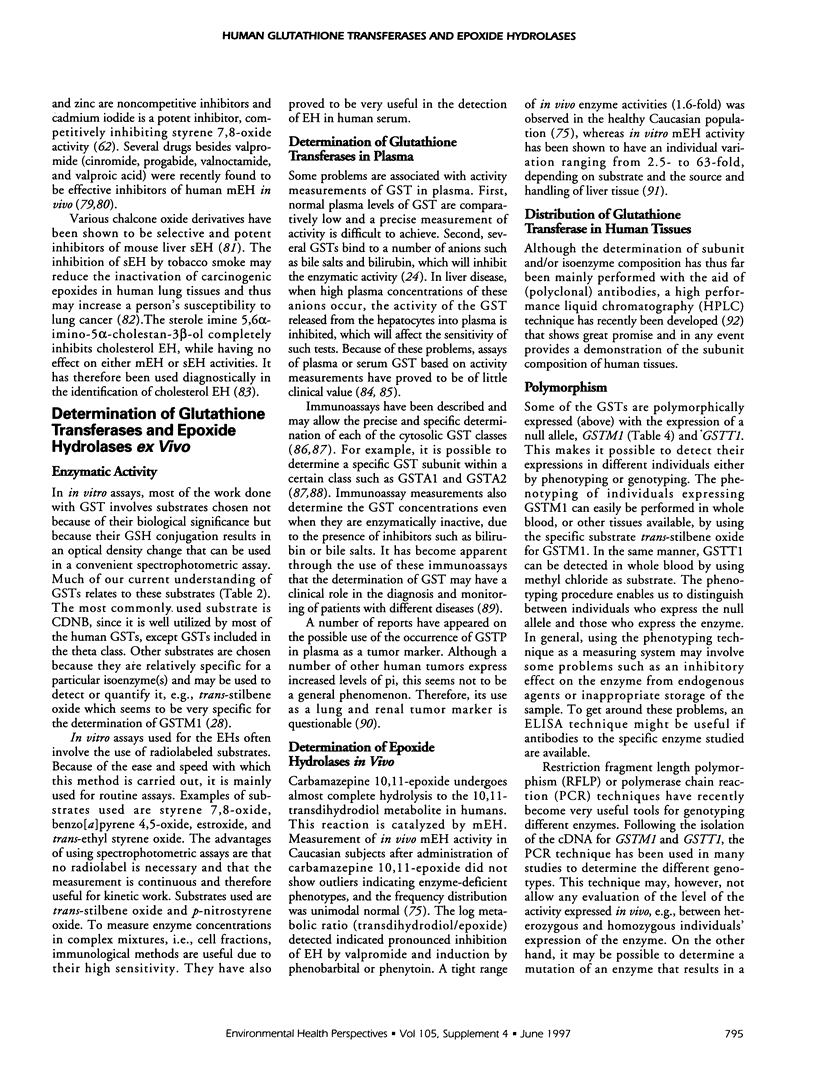
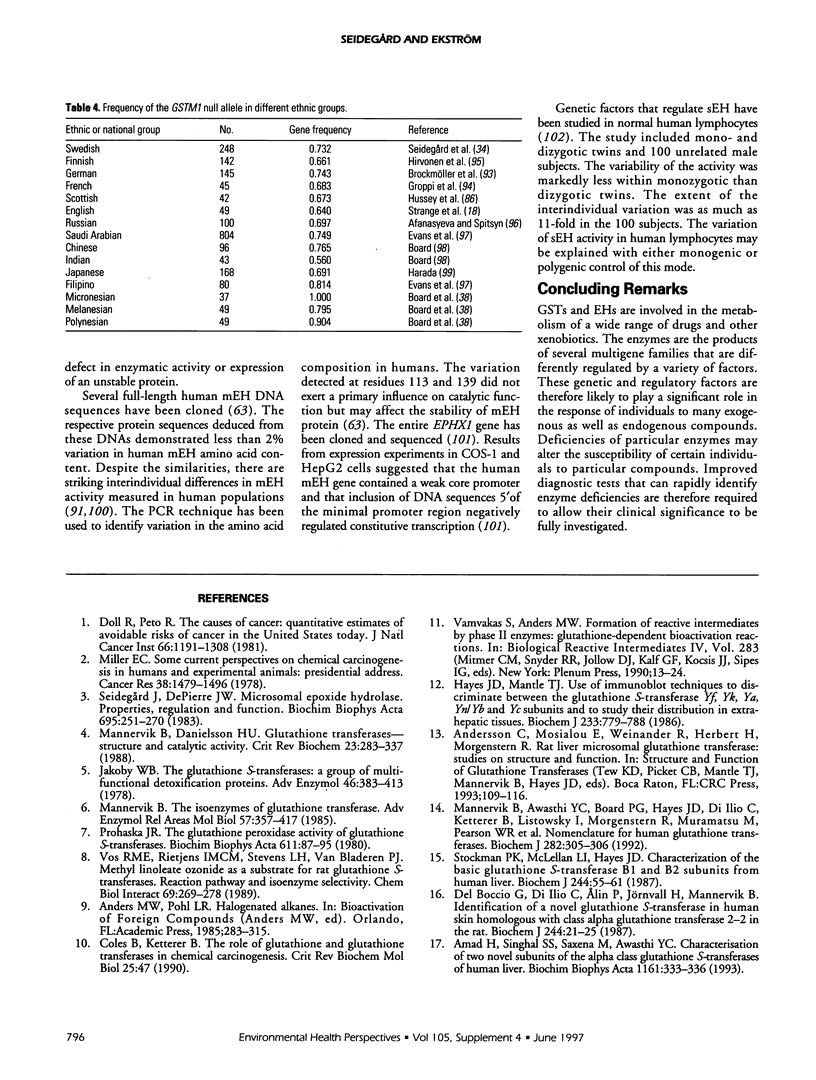
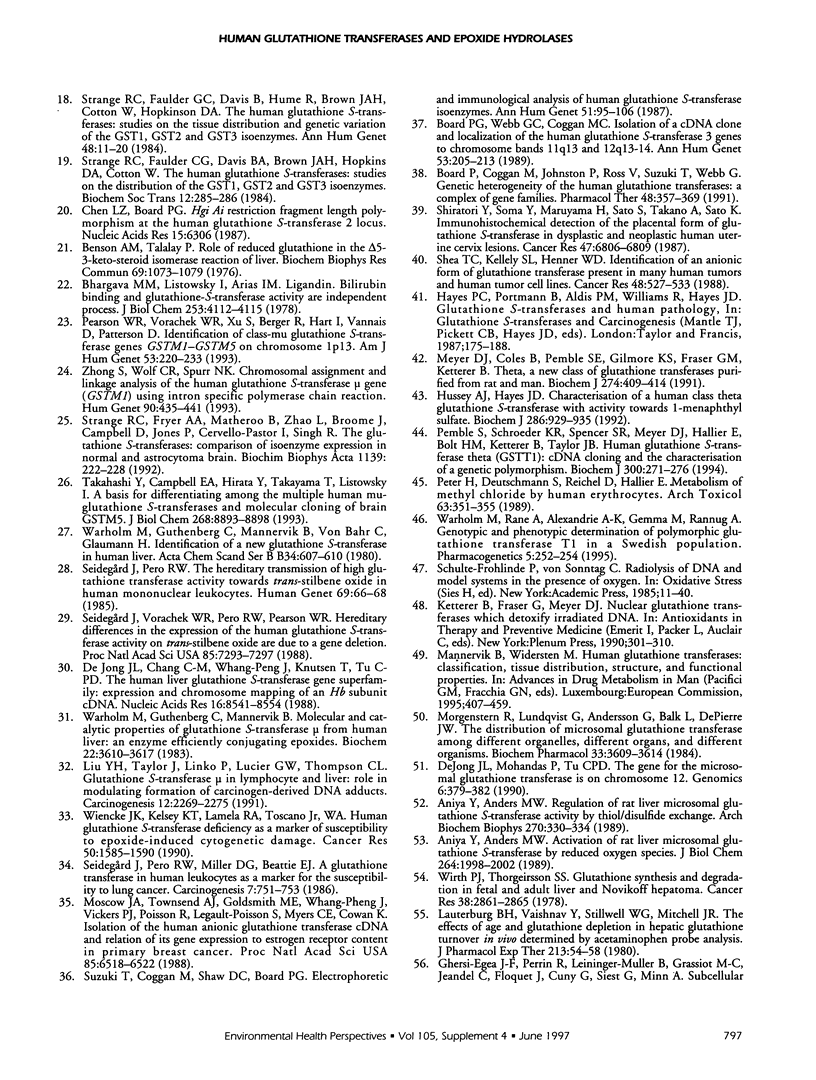
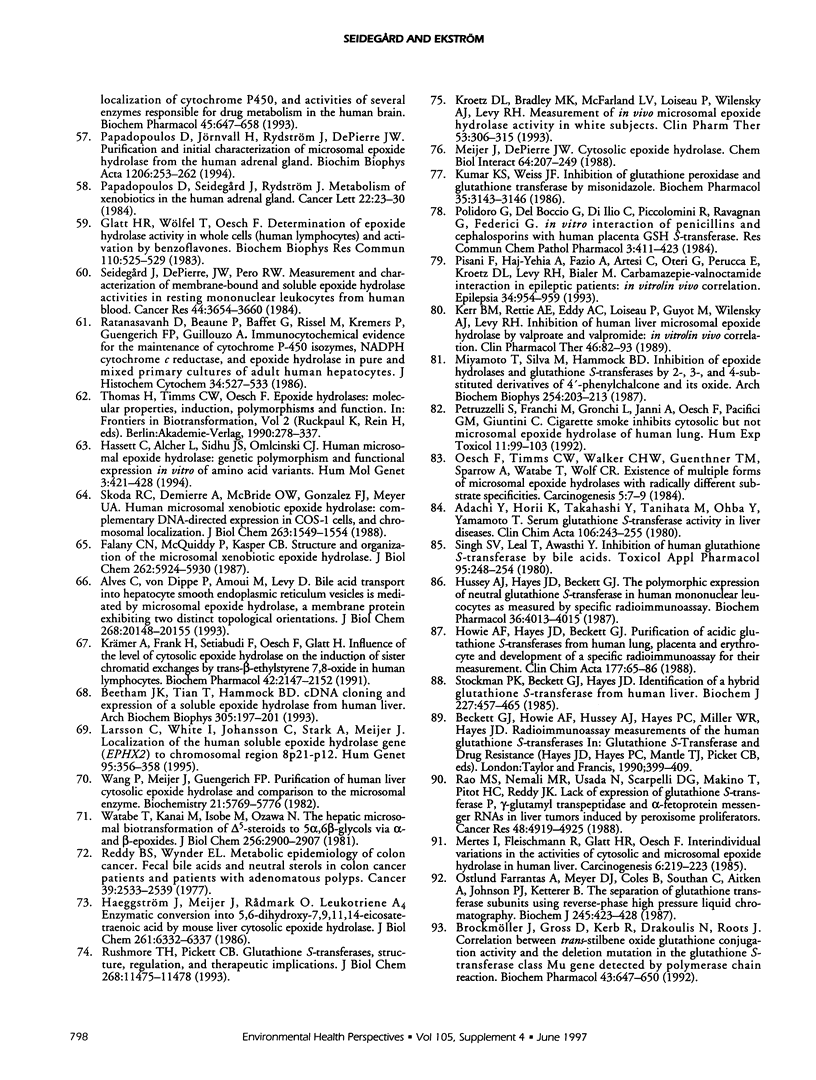

Selected References
These references are in PubMed. This may not be the complete list of references from this article.
- Adachi Y., Horii K., Takahashi Y., Tanihata M., Ohba Y., Yamamoto T. Serum glutathione S-transferase activity in liver diseases. Clin Chim Acta. 1980 Oct 9;106(3):243–255. doi: 10.1016/0009-8981(80)90308-3. [DOI] [PubMed] [Google Scholar]
- Afanas'eva I. S., Spitsyn V. A. Nasledstvennyi polimorfizm glutation-S-transferazy pecheni cheloveka v norme i pri alkogol'nom gepatite. Genetika. 1990 Jul;26(7):1309–1315. [PubMed] [Google Scholar]
- Ahmad H., Singhal S. S., Saxena M., Awasthi Y. C. Characterization of two novel subunits of the alpha-class glutathione S-transferases of human liver. Biochim Biophys Acta. 1993 Feb 13;1161(2-3):333–336. doi: 10.1016/0167-4838(93)90234-i. [DOI] [PubMed] [Google Scholar]
- Alves C., von Dippe P., Amoui M., Levy D. Bile acid transport into hepatocyte smooth endoplasmic reticulum vesicles is mediated by microsomal epoxide hydrolase, a membrane protein exhibiting two distinct topological orientations. J Biol Chem. 1993 Sep 25;268(27):20148–20155. [PubMed] [Google Scholar]
- Aniya Y., Anders M. W. Activation of rat liver microsomal glutathione S-transferase by reduced oxygen species. J Biol Chem. 1989 Feb 5;264(4):1998–2002. [PubMed] [Google Scholar]
- Aniya Y., Anders M. W. Regulation of rat liver microsomal glutathione S-transferase activity by thiol/disulfide exchange. Arch Biochem Biophys. 1989 Apr;270(1):330–334. doi: 10.1016/0003-9861(89)90035-0. [DOI] [PubMed] [Google Scholar]
- Beetham J. K., Tian T., Hammock B. D. cDNA cloning and expression of a soluble epoxide hydrolase from human liver. Arch Biochem Biophys. 1993 Aug 15;305(1):197–201. doi: 10.1006/abbi.1993.1411. [DOI] [PubMed] [Google Scholar]
- Benson A. M., Talalay P. Role of reduced glutathione in the delta(5)-3-kitosteroid isomerase reaction of liver. Biochem Biophys Res Commun. 1976 Apr 19;69(4):1073–1079. doi: 10.1016/0006-291x(76)90482-4. [DOI] [PubMed] [Google Scholar]
- Berlin G., Selbing A., Gottvall T. Plasma exchange and high-dose i.v. immunoglobulin in the treatment of severe rhesus hemolytic disease. Prog Clin Biol Res. 1990;337:337–340. [PubMed] [Google Scholar]
- Bhargava M. M., Listowsky I., Arias I. M. Ligandin. Bilirubin binding and glutathione-S-transferase activity are independent processes. J Biol Chem. 1978 Jun 25;253(12):4112–4115. [PubMed] [Google Scholar]
- Board P. G. Biochemical genetics of glutathione-S-transferase in man. Am J Hum Genet. 1981 Jan;33(1):36–43. [PMC free article] [PubMed] [Google Scholar]
- Board P. G., Webb G. C., Coggan M. Isolation of a cDNA clone and localization of the human glutathione S-transferase 3 genes to chromosome bands 11q13 and 12q13-14. Ann Hum Genet. 1989 Jul;53(Pt 3):205–213. doi: 10.1111/j.1469-1809.1989.tb01786.x. [DOI] [PubMed] [Google Scholar]
- Board P., Coggan M., Johnston P., Ross V., Suzuki T., Webb G. Genetic heterogeneity of the human glutathione transferases: a complex of gene families. Pharmacol Ther. 1990;48(3):357–369. doi: 10.1016/0163-7258(90)90054-6. [DOI] [PubMed] [Google Scholar]
- Brockmöller J., Gross D., Kerb R., Drakoulis N., Roots I. Correlation between trans-stilbene oxide-glutathione conjugation activity and the deletion mutation in the glutathione S-transferase class mu gene detected by polymerase chain reaction. Biochem Pharmacol. 1992 Feb 4;43(3):647–650. doi: 10.1016/0006-2952(92)90591-6. [DOI] [PubMed] [Google Scholar]
- Chen L. Z., Board P. G. Hgi AI restriction fragment length polymorphism at the human glutathione S-transferase 2 locus. Nucleic Acids Res. 1987 Aug 11;15(15):6306–6306. doi: 10.1093/nar/15.15.6306. [DOI] [PMC free article] [PubMed] [Google Scholar]
- Coles B., Ketterer B. The role of glutathione and glutathione transferases in chemical carcinogenesis. Crit Rev Biochem Mol Biol. 1990;25(1):47–70. doi: 10.3109/10409239009090605. [DOI] [PubMed] [Google Scholar]
- DeJong J. L., Chang C. M., Whang-Peng J., Knutsen T., Tu C. P. The human liver glutathione S-transferase gene superfamily: expression and chromosome mapping of an Hb subunit cDNA. Nucleic Acids Res. 1988 Sep 12;16(17):8541–8554. doi: 10.1093/nar/16.17.8541. [DOI] [PMC free article] [PubMed] [Google Scholar]
- DeJong J. L., Mohandas T., Tu C. P. The gene for the microsomal glutathione S-transferase is on human chromosome 12. Genomics. 1990 Feb;6(2):379–382. doi: 10.1016/0888-7543(90)90580-n. [DOI] [PubMed] [Google Scholar]
- Del Boccio G., Di Ilio C., Alin P., Jörnvall H., Mannervik B. Identification of a novel glutathione transferase in human skin homologous with class alpha glutathione transferase 2-2 in the rat. Biochem J. 1987 May 15;244(1):21–25. doi: 10.1042/bj2440021. [DOI] [PMC free article] [PubMed] [Google Scholar]
- Doll R., Peto R. The causes of cancer: quantitative estimates of avoidable risks of cancer in the United States today. J Natl Cancer Inst. 1981 Jun;66(6):1191–1308. [PubMed] [Google Scholar]
- Evans D. A., Seidegård J., Narayanan N. The GSTM1 genetic polymorphism in healthy Saudi Arabians and Filipinos, and Saudi Arabians with coronary atherosclerosis. Pharmacogenetics. 1996 Aug;6(4):365–367. doi: 10.1097/00008571-199608000-00011. [DOI] [PubMed] [Google Scholar]
- Falany C. N., McQuiddy P., Kasper C. B. Structure and organization of the microsomal xenobiotic epoxide hydrolase gene. J Biol Chem. 1987 Apr 25;262(12):5924–5930. [PubMed] [Google Scholar]
- Ghersi-Egea J. F., Perrin R., Leininger-Muller B., Grassiot M. C., Jeandel C., Floquet J., Cuny G., Siest G., Minn A. Subcellular localization of cytochrome P450, and activities of several enzymes responsible for drug metabolism in the human brain. Biochem Pharmacol. 1993 Feb 9;45(3):647–658. doi: 10.1016/0006-2952(93)90139-n. [DOI] [PubMed] [Google Scholar]
- Glatt H. R., Wölfel T., Oesch F. Determination of epoxide hydrolase activity in whole cells (human lymphocytes) and activation by benzoflavones. Biochem Biophys Res Commun. 1983 Jan 27;110(2):525–529. doi: 10.1016/0006-291x(83)91181-6. [DOI] [PubMed] [Google Scholar]
- Groppi A., Coutelle C., Fleury B., Iron A., Begueret J., Couzigou P. Glutathione S-transferase class mu in French alcoholic cirrhotic patients. Hum Genet. 1991 Sep;87(5):628–630. doi: 10.1007/BF00209028. [DOI] [PubMed] [Google Scholar]
- Haeggström J., Meijer J., Rådmark O. Leukotriene A4. Enzymatic conversion into 5,6-dihydroxy-7,9,11,14-eicosatetraenoic acid by mouse liver cytosolic epoxide hydrolase. J Biol Chem. 1986 May 15;261(14):6332–6337. [PubMed] [Google Scholar]
- Harada S., Abei M., Tanaka N., Agarwal D. P., Goedde H. W. Liver glutathione S-transferase polymorphism in Japanese and its pharmacogenetic importance. Hum Genet. 1987 Apr;75(4):322–325. doi: 10.1007/BF00284101. [DOI] [PubMed] [Google Scholar]
- Hassett C., Aicher L., Sidhu J. S., Omiecinski C. J. Human microsomal epoxide hydrolase: genetic polymorphism and functional expression in vitro of amino acid variants. Hum Mol Genet. 1994 Mar;3(3):421–428. doi: 10.1093/hmg/3.3.421. [DOI] [PMC free article] [PubMed] [Google Scholar]
- Hassett C., Robinson K. B., Beck N. B., Omiecinski C. J. The human microsomal epoxide hydrolase gene (EPHX1): complete nucleotide sequence and structural characterization. Genomics. 1994 Sep 15;23(2):433–442. doi: 10.1006/geno.1994.1520. [DOI] [PubMed] [Google Scholar]
- Hayes J. D., Mantle T. J. Use of immuno-blot techniques to discriminate between the glutathione S-transferase Yf, Yk, Ya, Yn/Yb and Yc subunits and to study their distribution in extrahepatic tissues. Evidence for three immunochemically distinct groups of transferase in the rat. Biochem J. 1986 Feb 1;233(3):779–788. doi: 10.1042/bj2330779. [DOI] [PMC free article] [PubMed] [Google Scholar]
- Hirvonen A., Husgafvel-Pursiainen K., Anttila S., Vainio H. The GSTM1 null genotype as a potential risk modifier for squamous cell carcinoma of the lung. Carcinogenesis. 1993 Jul;14(7):1479–1481. doi: 10.1093/carcin/14.7.1479. [DOI] [PubMed] [Google Scholar]
- Howie A. F., Hayes J. D., Beckett G. J. Purification of acidic glutathione S-transferases from human lung, placenta and erythrocyte and the development of a specific radioimmunoassay for their measurement. Clin Chim Acta. 1988 Sep 30;177(1):65–75. doi: 10.1016/0009-8981(88)90308-7. [DOI] [PubMed] [Google Scholar]
- Hussey A. J., Hayes J. D., Beckett G. J. The polymorphic expression of neutral glutathione S-transferase in human mononuclear leucocytes as measured by specific radioimmunoassay. Biochem Pharmacol. 1987 Nov 15;36(22):4013–4015. doi: 10.1016/0006-2952(87)90472-2. [DOI] [PubMed] [Google Scholar]
- Hussey A. J., Hayes J. D. Characterization of a human class-Theta glutathione S-transferase with activity towards 1-menaphthyl sulphate. Biochem J. 1992 Sep 15;286(Pt 3):929–935. doi: 10.1042/bj2860929. [DOI] [PMC free article] [PubMed] [Google Scholar]
- Jakoby W. B. The glutathione S-transferases: a group of multifunctional detoxification proteins. Adv Enzymol Relat Areas Mol Biol. 1978;46:383–414. doi: 10.1002/9780470122914.ch6. [DOI] [PubMed] [Google Scholar]
- Kerr B. M., Rettie A. E., Eddy A. C., Loiseau P., Guyot M., Wilensky A. J., Levy R. H. Inhibition of human liver microsomal epoxide hydrolase by valproate and valpromide: in vitro/in vivo correlation. Clin Pharmacol Ther. 1989 Jul;46(1):82–93. doi: 10.1038/clpt.1989.110. [DOI] [PubMed] [Google Scholar]
- Ketterer B., Fraser G., Meyer D. J. Nuclear glutathione transferases which detoxify irradiated DNA. Adv Exp Med Biol. 1990;264:301–310. doi: 10.1007/978-1-4684-5730-8_48. [DOI] [PubMed] [Google Scholar]
- Kroetz D. L., Kerr B. M., McFarland L. V., Loiseau P., Wilensky A. J., Levy R. H. Measurement of in vivo microsomal epoxide hydrolase activity in white subjects. Clin Pharmacol Ther. 1993 Mar;53(3):306–315. doi: 10.1038/clpt.1993.26. [DOI] [PubMed] [Google Scholar]
- Krämer A., Frank H., Setiabudi F., Oesch F., Glatt H. Influence of the level of cytosolic epoxide hydrolase on the induction of sister chromatid exchanges by trans-beta-ethylstyrene 7,8-oxide in human lymphocytes. Biochem Pharmacol. 1991 Nov 6;42(11):2147–2152. doi: 10.1016/0006-2952(91)90350-e. [DOI] [PubMed] [Google Scholar]
- Kumar K. S., Weiss J. F. Inhibition of glutathione peroxidase and glutathione transferase in mouse liver by misonidazole. Biochem Pharmacol. 1986 Sep 15;35(18):3143–3146. doi: 10.1016/0006-2952(86)90399-0. [DOI] [PubMed] [Google Scholar]
- Larsson C., White I., Johansson C., Stark A., Meijer J. Localization of the human soluble epoxide hydrolase gene (EPHX2) to chromosomal region 8p21-p12. Hum Genet. 1995 Mar;95(3):356–358. doi: 10.1007/BF00225209. [DOI] [PubMed] [Google Scholar]
- Lauterburg B. H., Vaishnav Y., Stillwell W. G., Mitchell J. R. The effects of age and glutathione depletion on hepatic glutathione turnover in vivo determined by acetaminophen probe analysis. J Pharmacol Exp Ther. 1980 Apr;213(1):54–58. [PubMed] [Google Scholar]
- Liu Y. H., Taylor J., Linko P., Lucier G. W., Thompson C. L. Glutathione S-transferase mu in human lymphocyte and liver: role in modulating formation of carcinogen-derived DNA adducts. Carcinogenesis. 1991 Dec;12(12):2269–2275. doi: 10.1093/carcin/12.12.2269. [DOI] [PubMed] [Google Scholar]
- Mannervik B., Awasthi Y. C., Board P. G., Hayes J. D., Di Ilio C., Ketterer B., Listowsky I., Morgenstern R., Muramatsu M., Pearson W. R. Nomenclature for human glutathione transferases. Biochem J. 1992 Feb 15;282(Pt 1):305–306. doi: 10.1042/bj2820305. [DOI] [PMC free article] [PubMed] [Google Scholar]
- Mannervik B., Danielson U. H. Glutathione transferases--structure and catalytic activity. CRC Crit Rev Biochem. 1988;23(3):283–337. doi: 10.3109/10409238809088226. [DOI] [PubMed] [Google Scholar]
- Mannervik B. The isoenzymes of glutathione transferase. Adv Enzymol Relat Areas Mol Biol. 1985;57:357–417. doi: 10.1002/9780470123034.ch5. [DOI] [PubMed] [Google Scholar]
- Meijer J., DePierre J. W. Cytosolic epoxide hydrolase. Chem Biol Interact. 1988;64(3):207–249. doi: 10.1016/0009-2797(88)90100-7. [DOI] [PubMed] [Google Scholar]
- Mertes I., Fleischmann R., Glatt H. R., Oesch F. Interindividual variations in the activities of cytosolic and microsomal epoxide hydrolase in human liver. Carcinogenesis. 1985 Feb;6(2):219–223. doi: 10.1093/carcin/6.2.219. [DOI] [PubMed] [Google Scholar]
- Meyer D. J., Coles B., Pemble S. E., Gilmore K. S., Fraser G. M., Ketterer B. Theta, a new class of glutathione transferases purified from rat and man. Biochem J. 1991 Mar 1;274(Pt 2):409–414. doi: 10.1042/bj2740409. [DOI] [PMC free article] [PubMed] [Google Scholar]
- Miller E. C. Some current perspectives on chemical carcinogenesis in humans and experimental animals: Presidential Address. Cancer Res. 1978 Jun;38(6):1479–1496. [PubMed] [Google Scholar]
- Miyamoto T., Silva M., Hammock B. D. Inhibition of epoxide hydrolases and glutathione S-transferases by 2-, 3-, and 4-substituted derivatives of 4'-phenylchalcone and its oxide. Arch Biochem Biophys. 1987 Apr;254(1):203–213. doi: 10.1016/0003-9861(87)90096-8. [DOI] [PubMed] [Google Scholar]
- Morgenstern R., Lundqvist G., Andersson G., Balk L., DePierre J. W. The distribution of microsomal glutathione transferase among different organelles, different organs, and different organisms. Biochem Pharmacol. 1984 Nov 15;33(22):3609–3614. doi: 10.1016/0006-2952(84)90145-x. [DOI] [PubMed] [Google Scholar]
- Moscow J. A., Townsend A. J., Goldsmith M. E., Whang-Peng J., Vickers P. J., Poisson R., Legault-Poisson S., Myers C. E., Cowan K. H. Isolation of the human anionic glutathione S-transferase cDNA and the relation of its gene expression to estrogen-receptor content in primary breast cancer. Proc Natl Acad Sci U S A. 1988 Sep;85(17):6518–6522. doi: 10.1073/pnas.85.17.6518. [DOI] [PMC free article] [PubMed] [Google Scholar]
- Oesch F., Timms C. W., Walker C. H., Guenthner T. M., Sparrow A., Watabe T., Wolf C. R. Existence of multiple forms of microsomal epoxide hydrolases with radically different substrate specificities. Carcinogenesis. 1984 Jan;5(1):7–9. doi: 10.1093/carcin/5.1.7. [DOI] [PubMed] [Google Scholar]
- Omiecinski C. J., Aicher L., Holubkov R., Checkoway H. Human peripheral lymphocytes as indicators of microsomal epoxide hydrolase activity in liver and lung. Pharmacogenetics. 1993 Jun;3(3):150–158. doi: 10.1097/00008571-199306000-00005. [DOI] [PubMed] [Google Scholar]
- Ostlund Farrants A. K., Meyer D. J., Coles B., Southan C., Aitken A., Johnson P. J., Ketterer B. The separation of glutathione transferase subunits by using reverse-phase high-pressure liquid chromatography. Biochem J. 1987 Jul 15;245(2):423–428. doi: 10.1042/bj2450423. [DOI] [PMC free article] [PubMed] [Google Scholar]
- Papadopoulos D., Jörnvall H., Rydström J., DePierre J. W. Purification and initial characterization of microsomal epoxide hydrolase from the human adrenal gland. Biochim Biophys Acta. 1994 Jun 12;1206(2):253–262. doi: 10.1016/0167-4838(94)90216-x. [DOI] [PubMed] [Google Scholar]
- Papadopoulos D., Seidegard J., Rydström J. Metabolism of xenobiotics in the human adrenal gland. Cancer Lett. 1984 Feb;22(1):23–30. doi: 10.1016/0304-3835(84)90039-9. [DOI] [PubMed] [Google Scholar]
- Pearson W. R., Vorachek W. R., Xu S. J., Berger R., Hart I., Vannais D., Patterson D. Identification of class-mu glutathione transferase genes GSTM1-GSTM5 on human chromosome 1p13. Am J Hum Genet. 1993 Jul;53(1):220–233. [PMC free article] [PubMed] [Google Scholar]
- Pemble S., Schroeder K. R., Spencer S. R., Meyer D. J., Hallier E., Bolt H. M., Ketterer B., Taylor J. B. Human glutathione S-transferase theta (GSTT1): cDNA cloning and the characterization of a genetic polymorphism. Biochem J. 1994 May 15;300(Pt 1):271–276. doi: 10.1042/bj3000271. [DOI] [PMC free article] [PubMed] [Google Scholar]
- Peter H., Deutschmann S., Reichel C., Hallier E. Metabolism of methyl chloride by human erythrocytes. Arch Toxicol. 1989;63(5):351–355. doi: 10.1007/BF00303122. [DOI] [PubMed] [Google Scholar]
- Petruzzelli S., Franchi M., Gronchi L., Janni A., Oesch F., Pacifici G. M., Giuntini C. Cigarette smoke inhibits cytosolic but not microsomal epoxide hydrolase of human lung. Hum Exp Toxicol. 1992 Mar;11(2):99–103. doi: 10.1177/096032719201100207. [DOI] [PubMed] [Google Scholar]
- Pisani F., Haj-Yehia A., Fazio A., Artesi C., Oteri G., Perucca E., Kroetz D. L., Levy R. H., Bialer M. Carbamazepine-valnoctamide interaction in epileptic patients: in vitro/in vivo correlation. Epilepsia. 1993 Sep-Oct;34(5):954–959. doi: 10.1111/j.1528-1157.1993.tb02117.x. [DOI] [PubMed] [Google Scholar]
- Prohaska J. R. The glutathione peroxidase activity of glutathione S-transferases. Biochim Biophys Acta. 1980 Jan 11;611(1):87–98. doi: 10.1016/0005-2744(80)90045-5. [DOI] [PubMed] [Google Scholar]
- Rao M. S., Nemali M. R., Usuda N., Scarpelli D. G., Makino T., Pitot H. C., Reddy J. K. Lack of expression of glutathione-S-transferase P, gamma-glutamyl transpeptidase, and alpha-fetoprotein messenger RNAs in liver tumors induced by peroxisome proliferators. Cancer Res. 1988 Sep 1;48(17):4919–4925. [PubMed] [Google Scholar]
- Ratanasavanh D., Beaune P., Baffet G., Rissel M., Kremers P., Guengerich F. P., Guillouzo A. Immunocytochemical evidence for the maintenance of cytochrome P-450 isozymes, NADPH cytochrome C reductase, and epoxide hydrolase in pure and mixed primary cultures of adult human hepatocytes. J Histochem Cytochem. 1986 Apr;34(4):527–533. doi: 10.1177/34.4.3081626. [DOI] [PubMed] [Google Scholar]
- Reddy B. S., Wynder E. L. Metabolic epidemiology of colon cancer. Fecal bile acids and neutral sterols in colon cancer patients and patients with adenomatous polyps. Cancer. 1977 Jun;39(6):2533–2539. doi: 10.1002/1097-0142(197706)39:6<2533::aid-cncr2820390634>3.0.co;2-x. [DOI] [PubMed] [Google Scholar]
- Rushmore T. H., Pickett C. B. Glutathione S-transferases, structure, regulation, and therapeutic implications. J Biol Chem. 1993 Jun 5;268(16):11475–11478. [PubMed] [Google Scholar]
- Seidegård J., DePierre J. W. Microsomal epoxide hydrolase. Properties, regulation and function. Biochim Biophys Acta. 1983 Dec 29;695(3-4):251–270. doi: 10.1016/0304-419x(83)90014-8. [DOI] [PubMed] [Google Scholar]
- Seidegård J., DePierre J. W., Pero R. W. Measurement and characterization of membrane-bound and soluble epoxide hydrolase activities in resting mononuclear leukocytes from human blood. Cancer Res. 1984 Sep;44(9):3654–3660. [PubMed] [Google Scholar]
- Seidegård J., Pero R. W., Miller D. G., Beattie E. J. A glutathione transferase in human leukocytes as a marker for the susceptibility to lung cancer. Carcinogenesis. 1986 May;7(5):751–753. doi: 10.1093/carcin/7.5.751. [DOI] [PubMed] [Google Scholar]
- Seidegård J., Pero R. W. The hereditary transmission of high glutathione transferase activity towards trans-stilbene oxide in human mononuclear leukocytes. Hum Genet. 1985;69(1):66–68. doi: 10.1007/BF00295531. [DOI] [PubMed] [Google Scholar]
- Seidegård J., Vorachek W. R., Pero R. W., Pearson W. R. Hereditary differences in the expression of the human glutathione transferase active on trans-stilbene oxide are due to a gene deletion. Proc Natl Acad Sci U S A. 1988 Oct;85(19):7293–7297. doi: 10.1073/pnas.85.19.7293. [DOI] [PMC free article] [PubMed] [Google Scholar]
- Shea T. C., Kelley S. L., Henner W. D. Identification of an anionic form of glutathione transferase present in many human tumors and human tumor cell lines. Cancer Res. 1988 Feb 1;48(3):527–533. [PubMed] [Google Scholar]
- Shiratori Y., Soma Y., Maruyama H., Sato S., Takano A., Sato K. Immunohistochemical detection of the placental form of glutathione S-transferase in dysplastic and neoplastic human uterine cervix lesions. Cancer Res. 1987 Dec 15;47(24 Pt 1):6806–6809. [PubMed] [Google Scholar]
- Singh S. V., Leal T., Awasthi Y. C. Inhibition of human glutathione S-transferases by bile acids. Toxicol Appl Pharmacol. 1988 Sep 15;95(2):248–254. doi: 10.1016/0041-008x(88)90161-5. [DOI] [PubMed] [Google Scholar]
- Skoda R. C., Demierre A., McBride O. W., Gonzalez F. J., Meyer U. A. Human microsomal xenobiotic epoxide hydrolase. Complementary DNA sequence, complementary DNA-directed expression in COS-1 cells, and chromosomal localization. J Biol Chem. 1988 Jan 25;263(3):1549–1554. [PubMed] [Google Scholar]
- Stockman P. K., Beckett G. J., Hayes J. D. Identification of a basic hybrid glutathione S-transferase from human liver. Glutathione S-transferase delta is composed of two distinct subunits (B1 and B2). Biochem J. 1985 Apr 15;227(2):457–465. doi: 10.1042/bj2270457. [DOI] [PMC free article] [PubMed] [Google Scholar]
- Stockman P. K., McLellan L. I., Hayes J. D. Characterization of the basic glutathione S-transferase B1 and B2 subunits from human liver. Biochem J. 1987 May 15;244(1):55–61. doi: 10.1042/bj2440055. [DOI] [PMC free article] [PubMed] [Google Scholar]
- Strange R. C., Faulder C. G., Davis B. A., Hume R., Brown J. A., Cotton W., Hopkinson D. A. The human glutathione S-transferases: studies on the tissue distribution and genetic variation of the GST1, GST2 and GST3 isozymes. Ann Hum Genet. 1984 Jan;48(Pt 1):11–20. doi: 10.1111/j.1469-1809.1984.tb00829.x. [DOI] [PubMed] [Google Scholar]
- Strange R. C., Fryer A. A., Matharoo B., Zhao L., Broome J., Campbell D. A., Jones P., Pastor I. C., Singh R. V. The human glutathione S-transferases: comparison of isoenzyme expression in normal and astrocytoma brain. Biochim Biophys Acta. 1992 Jul 7;1139(3):222–228. doi: 10.1016/0925-4439(92)90138-d. [DOI] [PubMed] [Google Scholar]
- Suzuki T., Coggan M., Shaw D. C., Board P. G. Electrophoretic and immunological analysis of human glutathione S-transferase isozymes. Ann Hum Genet. 1987 May;51(Pt 2):95–106. doi: 10.1111/j.1469-1809.1987.tb01051.x. [DOI] [PubMed] [Google Scholar]
- Takahashi Y., Campbell E. A., Hirata Y., Takayama T., Listowsky I. A basis for differentiating among the multiple human Mu-glutathione S-transferases and molecular cloning of brain GSTM5. J Biol Chem. 1993 Apr 25;268(12):8893–8898. [PubMed] [Google Scholar]
- Vamvakas S., Anders M. W. Formation of reactive intermediates by phase II enzymes: glutathione-dependent bioactivation reactions. Adv Exp Med Biol. 1991;283:13–24. doi: 10.1007/978-1-4684-5877-0_2. [DOI] [PubMed] [Google Scholar]
- Vesell E. S. Genetic factors that regulate cytosolic epoxide hydrolase activity in normal human lymphocytes. Ann Genet. 1991;34(3-4):167–172. [PubMed] [Google Scholar]
- Vos R. M., Rietjens I. M., Stevens L. H., Van Bladeren P. J. Methyl linoleate ozonide as a substrate for rat glutathione S-transferases: reaction pathway and isoenzyme selectivity. Chem Biol Interact. 1989;69(2-3):269–278. doi: 10.1016/0009-2797(89)90084-7. [DOI] [PubMed] [Google Scholar]
- Wang P., Meijer J., Guengerich F. P. Purification of human liver cytosolic epoxide hydrolase and comparison to the microsomal enzyme. Biochemistry. 1982 Nov 9;21(23):5769–5776. doi: 10.1021/bi00266a007. [DOI] [PubMed] [Google Scholar]
- Warholm M., Guthenberg C., Mannervik B. Molecular and catalytic properties of glutathione transferase mu from human liver: an enzyme efficiently conjugating epoxides. Biochemistry. 1983 Jul 19;22(15):3610–3617. doi: 10.1021/bi00284a011. [DOI] [PubMed] [Google Scholar]
- Warholm M., Rane A., Alexandrie A. K., Monaghan G., Rannug A. Genotypic and phenotypic determination of polymorphic glutathione transferase T1 in a Swedish population. Pharmacogenetics. 1995 Aug;5(4):252–254. doi: 10.1097/00008571-199508000-00010. [DOI] [PubMed] [Google Scholar]
- Watabe T., Kanai M., Isobe M., Ozawa N. The hepatic microsomal biotransformation of delta 5-steroids to 5 alpha, 6 beta-glycols via alpha- and beta-epoxides. J Biol Chem. 1981 Mar 25;256(6):2900–2907. [PubMed] [Google Scholar]
- Wiencke J. K., Kelsey K. T., Lamela R. A., Toscano W. A., Jr Human glutathione S-transferase deficiency as a marker of susceptibility to epoxide-induced cytogenetic damage. Cancer Res. 1990 Mar 1;50(5):1585–1590. [PubMed] [Google Scholar]
- Wirth P. J., Thorgeirsson S. S. Glutathione synthesis and degradation in fetal and adult rat liver and Novikoff hepatoma. Cancer Res. 1978 Sep;38(9):2861–2865. [PubMed] [Google Scholar]
- Zhong S., Wolf C. R., Spurr N. K. Chromosomal assignment and linkage analysis of the human glutathione S-transferase mu gene (GSTM1) using intron specific polymerase chain reaction. Hum Genet. 1992 Dec;90(4):435–439. doi: 10.1007/BF00220473. [DOI] [PubMed] [Google Scholar]


